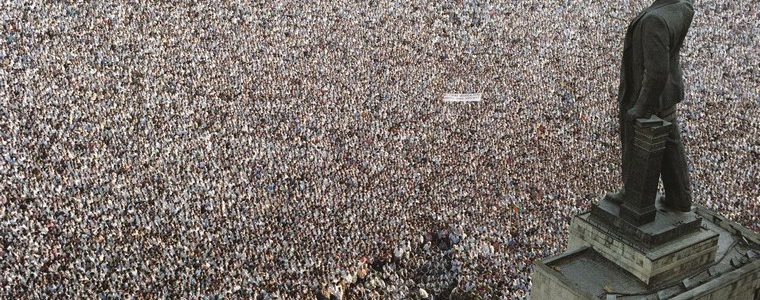On January 18, 1990, a group of US senators, including the future Secretary of State John Kerry, sent a letter to the USSR President Mikhail Gorbachev in connection with the pogroms of Armenians in Baku:
“We are deeply concerned about the killings, violence, and plunder of the Armenian population committed by groups of organized Azerbaijanis over the past six days.
We ask you to take measures to stop the killing of the Armenian minority, as well as other forms of violence in this region. The horrific outbreak of violence in Azerbaijan once again underlines the need for the reunification of 160 thousand Armenians of Nagorno-Karabakh with Armenia,” the senators wrote.
The testimony of Kushmanyan Vladimir, a former surgeon and refugee from Baku now living in Nashville, Tennessee, United States, contains invaluable details of the horrific events that took place in the capital of Azerbaijan in 1988-1989, the culmination of which was a new Armenian genocide committed in Baku on January 13-20, 1990. Kushmanyan was interviewed by the director of the project “Ordinary Genocide” Marina Grigoryan.
“I had to flee from Baku twice. The first happened in November 1988. We arrived in Moscow, from where we were transported to Yerevan a few days later, just the night before the 1988 Spitak earthquake.
We were settled in a kindergarten building where we would live until Gorbachev together with the First Secretary of the Central Committee of the Azerbaijani Communist Party announced that we could return and that we would be safe.
But when we returned to Baku, we immediately again felt the full horror of this hell. It is difficult to convey in words what was happening there and what heights the anti-Armenian hysteria had reached. It got to the point that my son’s arm was broken in a fight, so we addressed an emergency room on Gogol Street.
They mocked my wife at her workplace. She addressed the commandant of Baku General Kolesnikov and described the situation in detail. And in response, she received a mocking letter stating that there were no problems there and that everything was fine. Nevertheless, 12 workers of Armenian nationality left her workplace, and some simply retired.
Murder, mass harassment, and beatings occurred every day, it was simply impossible to live. They killed my dentist friend Grisha Stepanyan. He had returned to Baku to try to exchange an apartment. He was dragged into one of the buildings on Schmidt and Telefonnaya Streets and killed.
I had to flee the city for the second time in June 1989. We left all our property in Baku: we didn’t manage to take anything. Even almost all the photos were gone.
We arrived in Moscow and were forced to stay there. I appealed to both the USSR Prosecutor’s Office and Gorbachev, I wrote to all the top leaders of the USSR. But all my requests were redirected to the Ministry of Internal Affairs of the Azerbaijan SSR, that is, to those who did all these things.
By the way, in 1988, I also saw the so-called refugees from Armenia, from Kapan. Emissaries of the Popular Front of Azerbaijan met them at the station and gave them instructions on how to behave and what to do. They left all the things at the station. They were boarded onto buses and taken to rallies on Lenin Square.
I myself was on Lenin Square where the crowd was ordered: “All sit down! And the one who does not sit down is an Armenian.” Slogans like “death to the Armenians” were heard along with swearing and blatant lies about the events that had allegedly occurred in Kapan.
They said from the podium: “Do with their women the same what they did with our women in Armenia.” Already in 1988, inscriptions “death to Armenians”, “beat the Armenians”, “Armenians, get out of Baku” appeared in our building…
At the end of November 1989, I again arrived in Baku for several days, incognito. And I went to the headquarters of the Popular Front located on Schmidt Street. I spoke excellent Azeri, and it never even crossed their minds that I was an Armenian.
The headquarters were filled with dirty swearing addressed to Armenians, but the main thing I saw there were lists of addresses of the Armenians of Baku, which read something like the following: “Dear confreres, Azerbaijanis! Go and take away the property of the Armenians who have been robbing us all these years, enriching themselves and leaving us poor.”
I saw these lists with my own eyes. I even went upstairs and heard their conversations. I heard their plans and heard how they sent militants to the addresses.
I am sure that everything that happens is blessed from above. We later realized that all this talk about the army being three days, three hours, or 20 hours late was not true. It was necessary for someone, it was organized.
While still in Baku, I approached the people who arrived from Moscow (apparently, from the KGB) and asked them what was going on. They only shrugged. I even talked to senior officers of the Soviet army which entered the city, in particular, with one colonel. This colonel could not say anything either and remained silent.
Then, I learned that on the night of January 17 or 18, 1990, our apartment had been robbed by my neighbors. And, as far as I know, the cemetery in the area of the so-called Wolf Gate where my parents are buried had been subsequently destroyed.
My father was buried in the military part of the cemetery, at the entrance, and mother in the civilian part where most Armenians were buried. I don’t know if these cemeteries are there now or not, but I know for sure that the gravestones were stolen because they were made of valuable granite.”

